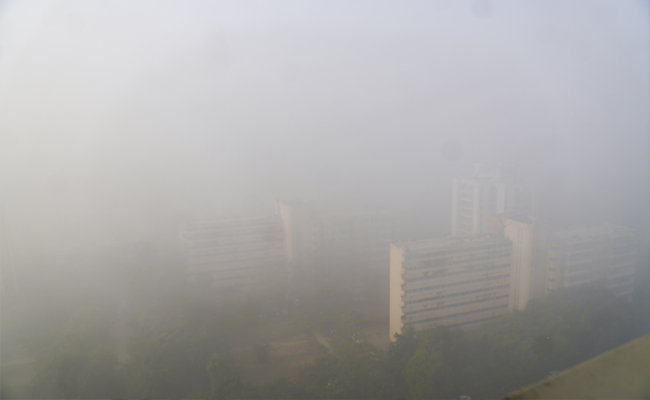Bengaluru, Aug 5: India's ambitious third Moon mission's 'Chandrayaan-3' spacecraft was successfully inserted into the lunar orbit on Saturday, ISRO said.
The required manoeuvre was done from an ISRO facility here, the city-headquartered national space agency said in a tweet.
"Chandrayaan-3 has been successfully inserted into the lunar orbit. A retro-burning at the Perilune was commanded from the Mission Operations Complex (MOX), ISTRAC (ISRO Telemetry, Tracking and Command Network), Bengaluru," the space agency said in a tweet.
Perilune is the spacecraft's closest point to the moon.
The next operation -- reduction of orbit -- will be done at 11 pm on Sunday, ISRO added.
The space agency also shared a message from the satellite to its centres, which read, "MOX, ISTRAC, this is Chandrayaan-3. I am feeling lunar gravity."
According to ISRO sources, there will be four more Moon-bound manoeuvres to bring the satellite closer to the Moon, which is a 100 kilometre circular orbit.
After the manoeuvre on Sunday, there will be three more till August 17, following which the landing module, comprising the lander and rover will break away from the propulsion module. After this, de-orbiting manoeuvres will be carried on the lander before the final descent on moon. According to ISRO, it would attempt soft landing on the Moon's surface on August 23.
Over five moves in the three weeks since the launch on July 14, ISRO has been lifting the Chandrayaan-3 spacecraft into orbits farther and farther away from the Earth.
Then, on August 1 in a key manoeuvre -- a slingshot move -- the spacecraft was sent successfully towards the Moon from Earth's orbit.
Following this trans-lunar injection, the Chandrayaan-3 spacecraft escaped from orbiting the Earth and began following a path that would take it to the vicinity of the moon.
Chandrayaan-3 is a follow-on mission to Chandrayaan-2 to demonstrate end-to-end capability in safe landing and roving on the lunar surface. It consists of lander and rover configuration.
It comprises an indigenous propulsion module, lander module, and a rover with an objective of developing and demonstrating new technologies required for inter-planetary missions.
The propulsion module will carry the lander and rover configuration till 100 km lunar orbit. The propulsion module has Spectro-polarimetry of Habitable Planet Earth (SHAPE) payload to study the spectral and polarimetric measurements of earth from the lunar orbit.
The mission objectives of Chandrayaan-3 are to demonstrate safe and soft landing on the lunar surface, to demonstrate rover roving on the Moon, and to conduct in-situ scientific experiments.
The lander will have the capability to soft land at a specified lunar site and deploy the rover that will carry out in-situ chemical analysis of the Moon's surface during the course of its mobility.
The lander and the rover have scientific payloads to carry out experiments on the lunar surface.
Chandrayaan-3 Mission:
— ISRO (@isro) August 5, 2023
“MOX, ISTRAC, this is Chandrayaan-3. I am feeling lunar gravity 🌖”
🙂
Chandrayaan-3 has been successfully inserted into the lunar orbit.
A retro-burning at the Perilune was commanded from the Mission Operations Complex (MOX), ISTRAC, Bengaluru.
The next… pic.twitter.com/6T5acwiEGb
Let the Truth be known. If you read VB and like VB, please be a VB Supporter and Help us deliver the Truth to one and all.
New Delhi (PTI): Dense fog disrupted flight operations at Delhi Airport on Monday, with various airlines cancelling 228 flights and diverting five to nearby airports due to low visibility, an official said.
However, except for Air India, which had in an X post in the morning announced the cancellation of some 40 flights, no other airlines, including crisis-hit IndiGo, shared the numbers of their cancelled or delayed flights.
"As many as 228 flights -- 131 departures and 97 arrivals-- have been cancelled due to low visibility, so far," the airport official said.
In addition to this, five flights have been diverted so far, he said.
Earlier, the Delhi International Airport Ltd (DIAL), in a statement, said, "Our on-ground officials are working closely with all stakeholders to assist passengers and provide necessary support across Terminals.
"Low visibility (below minima), due to dense fog, has severely impacted operations at Delhi and other airports across northern India, which is unfortunately beyond our control," IndiGo said in a statement.
As operations are adjusted to prevailing weather conditions, some flights may experience delays, while a few others may be proactively cancelled during the day to prioritise safety and minimise extended waiting at the airport, the airline said in a statement.
IndiGo, however, did not say how many of its flights were cancelled or delayed.
The airline said its teams are "closely monitoring" the situation and coordinating with Delhi airport.
ALSO READ: Messi's Delhi arrival delayed as fog disrupts flight
IndiGo also said it issued advisories to its customers and "proactively" informing them, to minimise inconvenience.
“Poor visibility due to dense fog in Delhi this morning has impacted flight operations for all airlines. We are closely monitoring conditions and will resume operations as soon as it is safe to do so,” Air India said in a post on X in the morning.
It also said that some flights have been cancelled In the interest of safety, and to avoid prolonged uncertainty for the guests, while listing out some 40 arrivals and departures that it had cancelled for the day.
Delhi airport is the country's busiest, handling around 1,300 flight movements daily.





